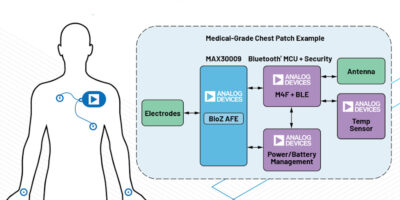MAX30009 can shrink remote patient monitoring devices, says Analog Devices
Bioimpedance remote patient monitoring devices can be reduced in sized and the lifetime extended, using the MAX30009 low power BioZ analogue front end (AFE) said Analog Devices.
It has been created for developers of small, battery-powered, continuously wearable devices. The AFE on a chip offers clinical-grade vital sign measurements of bioimpedance analysis for patient health assessment for wellness wearables and medical-grade patches.
The nature of vital signs monitors, chest patches, stress monitors, BioZ and other wearable healthcare devices means they must be small and compact, making them convenient and comfortable. They are required to operate on a small battery. The MAX30009 is a low-power design with a range of options to enable use-case power optimisation that reduces the draw on tiny batteries, and thereby extending the operational life of BioZ wearables. It is claimed to reduce power consumption by 62 per cent compared to the closest competitive product, enabling it to extend measurement periods for body-worn patches, and vital signs monitoring devices.
The level of integration means that the AFE is also 30 percent smaller than the closest competitor, continued Analog Devices. This allows designers to reduce the size of vital signs measurement devices, making them more comfortable and convenient for consumers and patients.
Bioimpedance analysis devices are popular and convenient ways healthcare professionals measure body fat percentage and body composition (such as respiration and impedance cardiography.) The MAX30009 monitors a comprehensive range of BioZ modalities through simultaneous I and Q measurements, two-electrode (bipolar) and four-electrode (tetrapolar) configurations.
This enables flexible inputs for BioZ modality measurements as well as a wide range of sample rates to support various medical BioZ measurements. Providing clinicians with a wider range, for example measuring respiration rate, galvanic skin response and electrodermal activity, body composition and fluid analysis, bioimpedance spectroscopy, impedance cardiography and plethysmography, allows more profound insights into patient health.
Sample rates are from 16 to four samples per second with a wide frequency range of 16Hz to 891KHz.
The MAX30009 is in production now. The company also offers the MAX30009EVKIT#.




